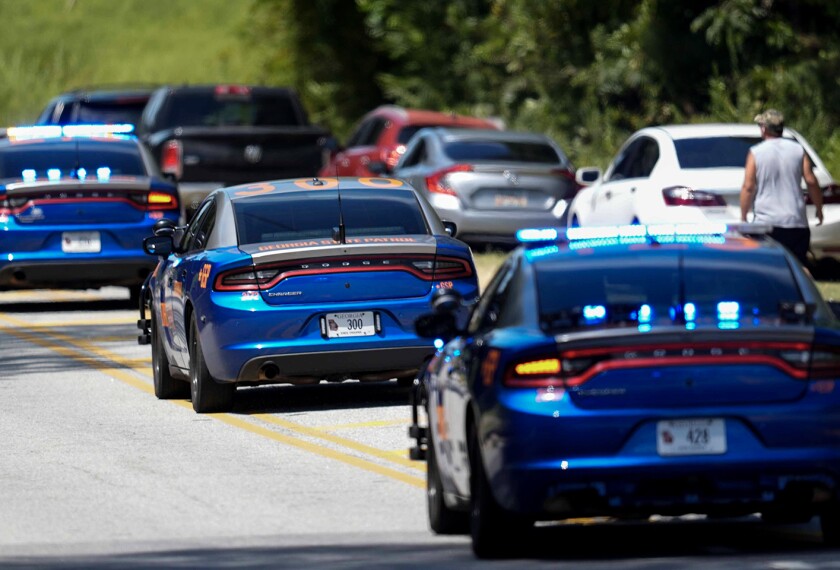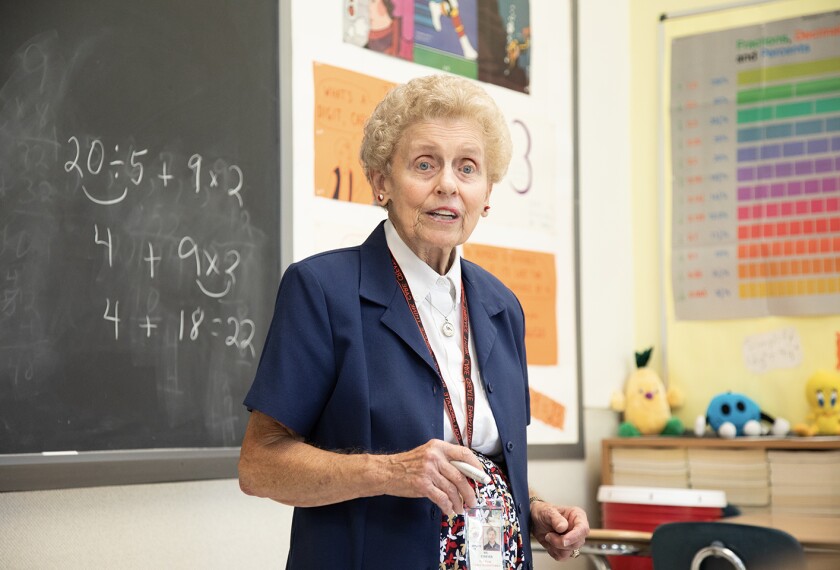The Sept. 4 school shooting at Apalachee High School in Winder, Ga., in which four people were killed, brought a renewed national attention to gun violence on K-12 grounds. The fallout—both emotional and economic—of such violent incidents can last years.
In the wake of a tragedy, schools need immediate financial assistance to fund a slew of emergency services to start rehabilitating their communities. School and district leaders can lean on a relatively lesser-known source of funding called Project SERV, or School Emergency Response to Violence.
Project SERV provides short-term, emergency funds to school districts, state education departments, and institutes of higher education to help them recover from a “violent or traumatic event in which the learning environment has been disrupted,” according to a spokesperson of the U.S. Department of Education.
Over the last five years, Project SERV grants have been administered to schools, colleges, and universities in a variety of situations. For example:
- The Newtown, Conn., school district received $6.3 million after the mass shooting at Sandy Hook Elementary, in which 20 1st graders and six educators were killed.
- The Hawaii State Department of Education received $2.1 million to give to schools after a series of wildfires in 2023 led to the widespread destruction of property and loss of lives.
- The Uvalde, Texas, school district was awarded a total of $3 million between 2022 and 2023 after a gunman killed 17 students and two educators at Robb Elementary School.
- Four historically Black colleges and universities—Howard University in the District of Columbia, Texas Southern University in Houston, Texas, Delaware State University in Dover, Del., and Claflin University in Orangeburg, S.C.—were awarded a total of $2.4 million to address disruptions caused by bomb threats in 2023.
- The Wynne school district in Arkansas was awarded $320,000 in 2023 to hire mental health and case workers after a string of tornadoes damaged classrooms and homes in the community.
In the wake of a school shooting or an unexpected natural disaster, school leaders are often unsure of the specific assistance they need, said Kathleen Gombos, the principal of Sandy Hook Elementary. Gombos was appointed three months after the shooting, and oversaw the recovery and rebuilding efforts, which included a temporary move to a new school building in a neighboring town.
“It’s not possible to just add a million dollars to a school’s budget [after a tragic or traumatic event]. There aren’t general funds available for dealing with something like this, since school budgets are set a year in advance,” Gombos said.
Here’s what you need to know about the history of this little-known federal grant, how schools benefit from it today, and how advocates want it to change in the future.
When did Project SERV begin?
In 1998, President Bill Clinton’s administration proposed a “federal crisis-intervention team” to respond to violent incidents at schools after a spate of school shootings in Jonesboro, Ark., Springfield, Ore., West Paducah, Ky., and Pearl, Miss.
The Clinton administration planned to earmark $12 million for services like crisis intervention experts and mental health counselors for students and teachers. The idea was to set up a response mechanism akin to the kind of support that communities receive from the Federal Emergency Management Agency after a hurricane or earthquake.
The proposal saw little uptake by Congress in 1998. But the 1999 mass shooting at Columbine High School in Colorado spurred Congress to fund Project SERV as a competitive and discretionary grant in 2000. The grant fund is under the purview of the Office of Elementary and Secondary Education in the Department of Education.
The first sizeable set of grants awarded were to the schools affected by the Sept. 11 terrorist attacks—grants totaling $8.7 million were awarded to school districts in New York, New Jersey, Virginia, Connecticut, Maryland, and the District of Columbia for “emergency counseling.” (In some cases, students and staff had lost a parent or relative in the attacks.)
How big is the Project SERV fund?
In the 2001 fiscal year, Project SERV had a budget of $10 million. Now, Project SERV has a budget of $5 million.
Under the National Activities for School Safety program, the Secretary of Education is required to reserve $5 million for Project SERV annually. Project SERV funds are rolled over to the next fiscal year, if they aren’t used fully in one.
The funds are disbursed to schools at the discretion of the Secretary of Education, and their size or duration may vary according to the scope of the incident and the resources needed to recover.
What can Project SERV fund?
After a disruptive or tragic event, schools need a multitude of services to return to normalcy. Project SERV grants can be used to hire mental health counselors, social workers, and school resource officers, or SROs, in case of a school shooting.
SERV grants can also help schools procure temporary security apparatus such as non-permanent metal detectors and security cameras, as well as hire extra guards in the short run. Schools may also use the grant toward relocation costs to a new building site—like Gombos did for Sandy Hook Elementary students.
Greg Johnson, the principal of West Liberty-Salem High School in West Liberty, Ohio, used the $160,000 awarded to his district in 2018 to hire an SRO, a law enforcement officer, and a part-time mental health counselor. The school had experienced a shooting in January 2017, when one student opened fire in a bathroom on another student, who, though critically injured, survived.
Johnson’s SERV grant took about 15 to16 months to process from the time of the shooting. In the meantime, the school had hired the extra help it needed, so the SERV grant went toward reimbursing the district for those services. Like Sandy Hook, West-Liberty Salem held onto its new recruits and used the district’s general fund to pay for those positions once the grant ran out.
West Liberty-Salem High didn’t have an SRO before the shooting. Now, seven years after creating the position, Johnson said the SRO has become “ingrained” in the school.
“He reads to kids. He helps coach varsity football. He’s in the lunchrooms and in the hallways,” he said. “He’s in full uniform, and he carries a gun. I think most of our teachers and students would say they feel safer in the building knowing that the SRO is present.”
Sandy Hook Elementary used its SERV grant over three years. One of its key uses was to hire substitute teachers and paraprofessionals to help the full-time staff cope with teaching in the aftermath of the shooting.
“I wanted to create a level playing field for the teachers. They were back two weeks after the incident. And it’s not like the standards changed for Newtown,” Gombos said. “Teachers would just go home tired because they had to keep coming back to the place where it had happened. They were barely making it through the day.”
When substitute teachers were in the classrooms, the full-time staff got a breather. They could also plan and collaborate and access mental health support during this time.
The SERV grant also allowed the school to hire paraprofessionals who helped deal with the increase in students’ behavioral issues, triggered by the shooting.
SERV grants, however, can’t be used to make any capital investments in a school building, like construction, permanent metal detectors, or security cameras.
Johnson, for instance, retrofitted school windows with bullet-resistant glass and added lock indicators to all the doors. These costs came out of the school’s budget and were not paid or reimbursed by the SERV grant.
Additionally, SERV funds can’t be used toward legal fees incurred by a district, its employees, students, or their families in any action taken against them in a civil court.
How can a school apply for a Project Serv grant?
The application is usually four to five pages long and should contain information about the incident and its impact on the “learning environment” of the school. Schools will need to provide details like the number of student absences or any increase in visits to a nurse or psychologist.
In some cases, however, the Education Department can expedite the support to a school district, when a large-scale, traumatic mass shooting takes place, like the ones at Sandy Hook and Robb Elementary.
In most cases, the Education Department reaches out to the state’s education agency and channels its grants through them—first to the affected district, and then to the specific school. The department may also reach out directly to the district and help them apply for the funding. The grantee must be a state agency or a school district.
Applications are accepted continuously and there is “no set” due date.
The Principal Recovery Network, a support group for principals run by the National Association of Secondary School Principals, includes information about the SERV grant in its outreach toward principals who have experienced a shooting or violent incident in their schools.
What changes do advocates want the Education Department to make to Project SERV?
The notoriety and scale of an incident appears to matter in terms of how quickly a school district is helped.
At Sandy Hook, Gombos said the SERV grant had already been set up by the time she was appointed, three months after the incident. By contrast, other school leaders may have to wait months for the funding, especially if they weren’t aware of the grant when the violence or disaster at their school occurred.
Johnson is hopeful that the grant size will increase beyond its current $5 million appropriation, which might spur the Education Department to look for more schools to support.
“Mass shootings, hurricanes, or tornadoes, thankfully, don’t happen as often. But there are non-fatal shootings in schools almost every week, and we’ve found that those incidents also traumatize students and staff. Those schools also need support,” Johnson said.
Gombos and Johnson also suggested that the Education Department give examples of how the funding has been used by previous grantees.
Sandy Hook’s use of substitute teachers and paraprofessionals, Gombos said, could help trigger ideas for other school leaders. Meanwhile, Johnson felt, in retrospect, he could have used SERV grants to formally train his staff on trauma-informed care.
Project SERV does assign an officer to oversee how the grant is being executed and help the grantees re-apply if they need a second installment. Most schools, though, don’t seek additional funding, the Education Department spokesperson said.
Warman Hall, the director of federal programs for the Aztec municipal school district in New Mexico, which experienced a school shooting in 2017, said the department could also consider creating different bucket of grants for natural disaster recovery, separate from the just-in-time funding to recover from a violent incident in a school.
“It would be nice to have a separate grant for this because, unfortunately, it seems to be a perennial issue,” he said.
Disclaimer: The copyright of this article belongs to the original author. Reposting this article is solely for the purpose of information dissemination and does not constitute any investment advice. If there is any infringement, please contact us immediately. We will make corrections or deletions as necessary. Thank you.







